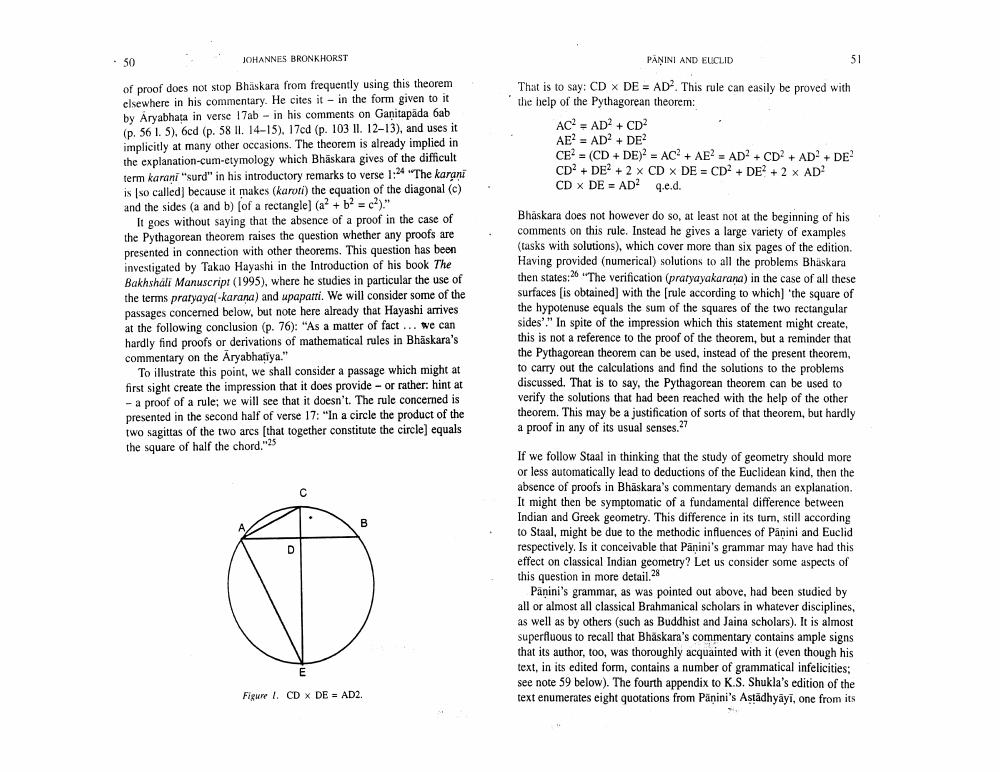Book Title: Panini And Euclid Reflections On Indian Geometry Author(s): Johannes Bronkhorst Publisher: Johannes Bronkhorst View full book textPage 5
________________ · 50 JOHANNES BRONKHORST of proof does not stop Bhaskara from frequently using this theorem elsewhere in his commentary. He cites it in the form given to it by Aryabhata in verse 17ab in his comments on Ganitapada 6ab (p. 56 1. 5), 6cd (p. 58 II. 14-15), 17cd (p. 103 II. 12-13), and uses it implicitly at many other occasions. The theorem is already implied in the explanation-cum-etymology which Bhaskara gives of the difficult term karani "surd" in his introductory remarks to verse 1:24 "The karani is [so called] because it makes (karoti) the equation of the diagonal (c) and the sides (a and b) [of a rectangle] (a2+ b2 = c2)." It goes without saying that the absence of a proof in the case of the Pythagorean theorem raises the question whether any proofs are presented in connection with other theorems. This question has been investigated by Takao Hayashi in the Introduction of his book The Bakhshali Manuscript (1995), where he studies in particular the use of the terms pratyaya(-karana) and upapatti. We will consider some of the passages concerned below, but note here already that Hayashi arrives at the following conclusion (p. 76): "As a matter of fact... we can hardly find proofs or derivations of mathematical rules in Bhaskara's commentary on the Aryabhatiya." To illustrate this point, we shall consider a passage which might at first sight create the impression that it does provide - or rather: hint at - a proof of a rule; we will see that it doesn't. The rule concerned is presented in the second half of verse 17: "In a circle the product of the two sagittas of the two arcs [that together constitute the circle] equals the square of half the chord."25 B E Figure 1. CD x DE = AD2. PANINI AND EUCLID That is to say: CD x DE = AD2. This rule can easily be proved with the help of the Pythagorean theorem: 51 AC2 = AD2 + CD2 AE2 = AD2 + DE2 CE2 (CD + DE)2= AC2+ AE2 = AD2+ CD2 + AD2 + DE2 CD2+ DE2 + 2 x CD x DE = CD2+ DE2 + 2 x AD2 CD x DE = AD2 q.e.d. Bhaskara does not however do so, at least not at the beginning of his comments on this rule. Instead he gives a large variety of examples (tasks with solutions), which cover more than six pages of the edition. Having provided (numerical) solutions to all the problems Bhaskara then states:26 The verification (pratyayakarana) in the case of all these surfaces [is obtained] with the [rule according to which] 'the square of the hypotenuse equals the sum of the squares of the two rectangular sides'." In spite of the impression which this statement might create, this is not a reference to the proof of the theorem, but a reminder that the Pythagorean theorem can be used, instead of the present theorem, to carry out the calculations and find the solutions to the problems discussed. That is to say, the Pythagorean theorem can be used to verify the solutions that had been reached with the help of the other theorem. This may be a justification of sorts of that theorem, but hardly a proof in any of its usual senses.27 If we follow Staal in thinking that the study of geometry should more or less automatically lead to deductions of the Euclidean kind, then the absence of proofs in Bhaskara's commentary demands an explanation. It might then be symptomatic of a fundamental difference between Indian and Greek geometry. This difference in its turn, still according to Staal, might be due to the methodic influences of Panini and Euclid respectively. Is it conceivable that Panini's grammar may have had this effect on classical Indian geometry? Let us consider some aspects of this question in more detail.28 Panini's grammar, as was pointed out above, had been studied by all or almost all classical Brahmanical scholars in whatever disciplines, as well as by others (such as Buddhist and Jaina scholars). It is almost superfluous to recall that Bhaskara's commentary contains ample signs that its author, too, was thoroughly acquainted with it (even though his text, in its edited form, contains a number of grammatical infelicities; see note 59 below). The fourth appendix to K.S. Shukla's edition of the text enumerates eight quotations from Panini's Astādhyāyī, one from itsPage Navigation
1 ... 3 4 5 6 7 8 9 10 11 12 13 14 15 16 17 18 19 20
